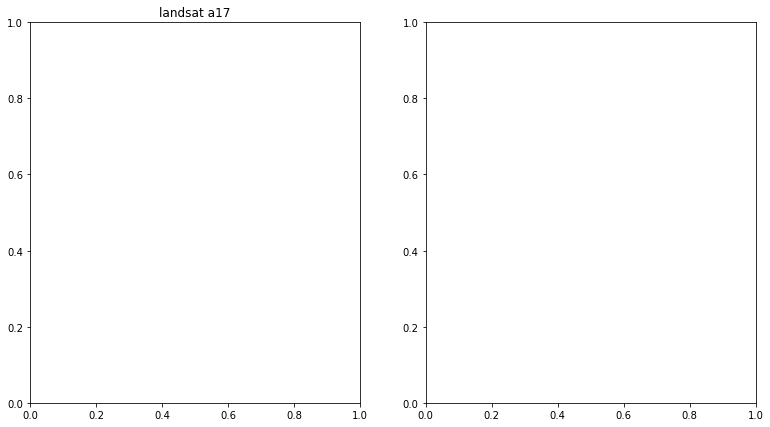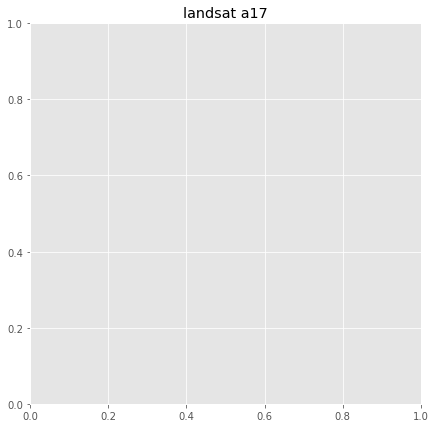Table of Contents
1 2D histogram of the optical depth \(\tau\)
1.1 Character of the optical depth field
1.2 ubc_fft class
2 Problem – lowpass filtering of a 2-d image
2D histogram of the optical depth \(\tau\)¶
Below I calculate the 2-d and averaged 1-d spectra for the optical depth, which gives the penetration depth of photons through a cloud, and is closely related to cloud thickness
[1]:
import warnings
warnings.filterwarnings("ignore",category=FutureWarning)
[2]:
from matplotlib import pyplot as plt
import urllib
import os
filelist=['a17.nc']
data_download=True
if data_download:
for the_file in filelist:
url='http://clouds.eos.ubc.ca/~phil/docs/atsc500/data/{}'.format(the_file)
urllib.request.urlretrieve(url,the_file)
print("download {}: size is {:6.2g} Mbytes".format(the_file,os.path.getsize(the_file)*1.e-6))
download a17.nc: size is 17 Mbytes
[3]:
from netCDF4 import Dataset
with Dataset(filelist[0]) as nc:
tau=nc.variables['tau'][...]
---------------------------------------------------------------------------
ModuleNotFoundError Traceback (most recent call last)
<ipython-input-3-de5fe010b18b> in <module>
----> 1 from netCDF4 import Dataset
2 with Dataset(filelist[0]) as nc:
3 tau=nc.variables['tau'][...]
ModuleNotFoundError: No module named 'netCDF4'
Character of the optical depth field¶
The image below shows one of the marine boundary layer landsat scenes analyzed in Lewis et al., 2004
It is a 2048 x 2048 pixel image taken by Landsat 7, with the visible reflectivity converted to cloud optical depth. The pixels are 25 m x 25 m, so the scene extends for about 50 km x 50 km
[4]:
%matplotlib inline
from mpl_toolkits.axes_grid1 import make_axes_locatable
plt.close('all')
fig,ax=plt.subplots(1,2,figsize=(13,7))
ax[0].set_title('landsat a17')
im0=ax[0].imshow(tau)
im1=ax[1].hist(tau.ravel())
ax[1].set_title('histogram of tau values')
divider = make_axes_locatable(ax[0])
cax = divider.append_axes("bottom", size="5%", pad=0.35)
out=fig.colorbar(im0,orientation='horizontal',cax=cax)
---------------------------------------------------------------------------
NameError Traceback (most recent call last)
<ipython-input-4-175f0c57cfd9> in <module>
4 fig,ax=plt.subplots(1,2,figsize=(13,7))
5 ax[0].set_title('landsat a17')
----> 6 im0=ax[0].imshow(tau)
7 im1=ax[1].hist(tau.ravel())
8 ax[1].set_title('histogram of tau values')
NameError: name 'tau' is not defined

ubc_fft class¶
In the next cell I define a class that calculates the 2-d fft for a square image
in the method power_spectrum we calculate both the 2d fft and the power spectrum and save them as class attributes. In the method annular_average I take the power spectrum, which is the two-dimensional field \(E(k_x, k_y)\) (in cartesian coordinates) or \(E(k,\theta)\) (in polar coordinates). In the method annular_avg I take the average
and plot that average with the method graph_spectrum
[5]:
from netCDF4 import Dataset
import numpy as np
import math
from numpy import fft
from matplotlib import pyplot as plt
class ubc_fft:
def __init__(self, filename, var, scale):
"""
Input filename, var=variable name,
scale= the size of the pixel in km
Constructer opens the netcdf file, reads the data and
saves the twodimensional fft
"""
with Dataset(filename,'r') as fin:
data = fin.variables[var][...]
data = data - data.mean()
if data.shape[0] != data.shape[1]:
raise ValueError('expecting square matrix')
self.xdim = data.shape[0] # size of each row of the array
self.midpoint = int(math.floor(self.xdim/2))
root,suffix = filename.split('.')
self.filename = root
self.var = var
self.scale = float(scale)
self.data = data
self.fft_data = fft.fft2(self.data)
def power_spectrum(self):
"""
calculate the power spectrum for the 2-dimensional field
"""
#
# fft_shift moves the zero frequency point to the middle
# of the array
#
fft_shift = fft.fftshift(self.fft_data)
spectral_dens = fft_shift*np.conjugate(fft_shift)/(self.xdim*self.xdim)
spectral_dens = spectral_dens.real
#
# dimensional wavenumbers for 2dim spectrum (need only the kx
# dimensional since image is square
#
k_vals = np.arange(0,(self.midpoint))+1
k_vals = (k_vals-self.midpoint)/(self.xdim*self.scale)
self.spectral_dens=spectral_dens
self.k_vals=k_vals
def annular_avg(self,avg_binwidth):
"""
integrate the 2-d power spectrum around a series of rings
of radius kradial and average into a set of 1-dimensional
radial bins
"""
#
# define the k axis which is the radius in the 2-d polar version of E
#
numbins = int(round((math.sqrt(2)*self.xdim/avg_binwidth),0)+1)
avg_spec = np.zeros(numbins,np.float64)
bin_count = np.zeros(numbins,np.float64)
print("\t- INTEGRATING... ")
for i in range(self.xdim):
if (i%100) == 0:
print("\t\trow: {} completed".format(i))
for j in range(self.xdim):
kradial = math.sqrt(((i+1)-self.xdim/2)**2+((j+1)-self.xdim/2)**2)
bin_num = int(math.floor(kradial/avg_binwidth))
avg_spec[bin_num]=avg_spec[bin_num]+ kradial*self.spectral_dens[i,j]
bin_count[bin_num]+=1
for i in range(numbins):
if bin_count[i]>0:
avg_spec[i]=avg_spec[i]*avg_binwidth/bin_count[i]/(4*(math.pi**2))
self.avg_spec=avg_spec
#
# dimensional wavenumbers for 1-d average spectrum
#
self.k_bins=np.arange(numbins)+1
self.k_bins = self.k_bins[0:self.midpoint]
self.avg_spec = self.avg_spec[0:self.midpoint]
def graph_spectrum(self, kol_slope=-5./3., kol_offset=1., \
title=None):
"""
graph the annular average and compare it to Kolmogorov -5/3
"""
avg_spec=self.avg_spec
delta_k = 1./self.scale # 1./km (1/0.025 for landsat 25 meter pixels)
nyquist = delta_k * 0.5
knum = self.k_bins * (nyquist/float(len(self.k_bins)))# k = w/(25m)
#
# draw the -5/3 line through a give spot
#
kol = kol_offset*(knum**kol_slope)
fig,ax=plt.subplots(1,1,figsize=(8,8))
ax.loglog(knum,avg_spec,'r-',label='power')
ax.loglog(knum,kol,'k-',label="$k^{-5/3}$")
ax.set(title=title,xlabel='k (1/km)',ylabel='$E_k$')
ax.legend()
self.plotax=ax
---------------------------------------------------------------------------
ModuleNotFoundError Traceback (most recent call last)
<ipython-input-5-1160ff0ea453> in <module>
----> 1 from netCDF4 import Dataset
2 import numpy as np
3 import math
4 from numpy import fft
5 from matplotlib import pyplot as plt
ModuleNotFoundError: No module named 'netCDF4'
[6]:
plt.close('all')
plt.style.use('ggplot')
output = ubc_fft('a17.nc','tau',0.025)
output.power_spectrum()
---------------------------------------------------------------------------
NameError Traceback (most recent call last)
<ipython-input-6-9db3b82f7726> in <module>
1 plt.close('all')
2 plt.style.use('ggplot')
----> 3 output = ubc_fft('a17.nc','tau',0.025)
4 output.power_spectrum()
NameError: name 'ubc_fft' is not defined
[7]:
fig,ax=plt.subplots(1,1,figsize=(7,7))
ax.set_title('landsat a17')
im0=ax.imshow(np.log10(output.spectral_dens))
ax.set_title('log10 of the 2-d power spectrum')
divider = make_axes_locatable(ax)
cax = divider.append_axes("bottom", size="5%", pad=0.35)
out=fig.colorbar(im0,orientation='horizontal',cax=cax)
---------------------------------------------------------------------------
NameError Traceback (most recent call last)
<ipython-input-7-1c455b045451> in <module>
1 fig,ax=plt.subplots(1,1,figsize=(7,7))
2 ax.set_title('landsat a17')
----> 3 im0=ax.imshow(np.log10(output.spectral_dens))
4 ax.set_title('log10 of the 2-d power spectrum')
5 divider = make_axes_locatable(ax)
NameError: name 'np' is not defined

[8]:
avg_binwidth=5 #make the kradial bins 5 pixels wide
output.annular_avg(avg_binwidth)
---------------------------------------------------------------------------
NameError Traceback (most recent call last)
<ipython-input-8-195506f4bc01> in <module>
1 avg_binwidth=5 #make the kradial bins 5 pixels wide
----> 2 output.annular_avg(avg_binwidth)
NameError: name 'output' is not defined
[9]:
output.graph_spectrum(kol_offset=2000.,title='Landsat {} power spectrum'.format(output.filename))
---------------------------------------------------------------------------
NameError Traceback (most recent call last)
<ipython-input-9-7432139d473b> in <module>
----> 1 output.graph_spectrum(kol_offset=2000.,title='Landsat {} power spectrum'.format(output.filename))
NameError: name 'output' is not defined
Problem – lowpass filtering of a 2-d image¶
For the image above, we know that the 25 meter pixels correspond to k=1/0.025 = 40 \(km^{-1}\). That means that the Nyquist wavenumber is k=20 \(km^{-1}\). Using that information, design a filter that removes all wavenumbers higher than 1 \(km^{-1}\).
Use that filter to zero those values in the fft, then inverse transform and plot the low-pass filtered image.
Take the 1-d fft of the image and repeat the plot of the power spectrum to show that there is no power in wavenumbers higher than 1 \(km^{-1}\).
(Hint – I used the fftshift function to put the low wavenumber cells in the center of the fft, which made it simpler to zero the outer cells. I then used ifftshift to reverse shift before inverse transforming to get the filtered image.)
[ ]: